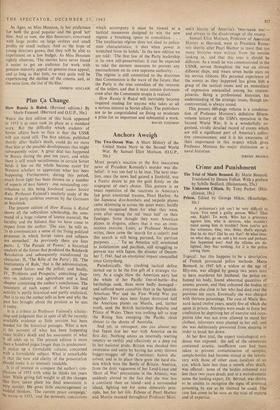Plus Ca Change
WHEN the first edition of this book appeared in 1953 it at once took its place as a standard work. But the difficulty which students of Soviet affairs have to face is that the USSR will not stand still. The first edition, published shortly after Stalin's death, could do no more than hint at the possible developments that might subsequently occur. A great deal has happened in Russia during the past ten years, and while there is still much secretiveness in certain Soviet fields it has on the whole become easier for Western scholars to appreciate what has been happening. Furthermore, during this period, much fresh light has been thrown on a number of aspects of past history: one outstanding con- tribution to this being Smolensk under Soviet Rule, Professor Fainsod's masterly study of the mass of party archives overrun by the Germans at Smolensk.
The present edition of How Russia is Ruled shows all the meticulous scholarship, the com- mand of a huge volume of 'source material, the lucidity and the balance that we have come to expect from the author. 'The aim,' he tells us, 'is to communicate a sense of the living political processes in which Soviet rulers and subjects are enmeshed.' As previously there are four parts: 1, 'The Pursuit of Power,' a historical analysis of the forces that Produced the Bolshevik Revolution and subsequently transformed its character; 11, 'The Role of the Party'; III, `The Instruments of Rule,' that is the administration, the armed forces and the police; and finally, 1V, 'Problems and Prospects,' containing chap- ters on industry and agriculture and a final chapter containing the author's conclusions. The treatment of each aspect of Soviet life and activity is partly historical and partly analytical, that is to say the author tells us how and why the past has brought about the position as he sees it today.
It is a tribute to Professor Fainsod's scholar- ship and judgment that in spite of all the recently available evidence so little revision has been needed for the historical passages. What is new is his account of what has been happening since Stalin's death and his assessment of what It all adds up to. The present edition is more than a hundred pages longer than its predecessor. It makes up a forMidable volume, concerned With a formidable subject. What is remarkable is that the ease and clarity of the presentation Should make it so intensely readable.
It is of interest to compare the author's con- clusions of 1953 with what he thinks ten years later. While giving full weight to all the changes that have taken place his final assessment is very similar. He gives little encouragement to Wishful thinkers. 'The current peace campaign,' he wrote in 1953, 'and the domestic concessions
which accompany it must be viewed as a tactical manoeuvre designed to win the new regime a breathing space to consolidate. . . • The totalitarian regime does not shed its police- state characteristics; it dies when power is wrenched from its hafids.' In the new edition we are told: 'The first law of the Party leadership is its own self-preservation; it can be expected to take the sternest measures to prevent any encroachment on its own supreme authority.... The regime is still committed to the doctrines that Communism is the wave of the future, that the Party is the true custodian of the interests of the toilers, and that it must remain dominant even after the Communist utopia is realised.'
How Russia is Ruled will inevitably become required reading for anyone who takes at all a serious interest in Soviet affairs. The publishers are to be congratulated on fixing so moderate a price for so important and substantial a work.
DAVID FOOTMAN






























 Previous page
Previous page